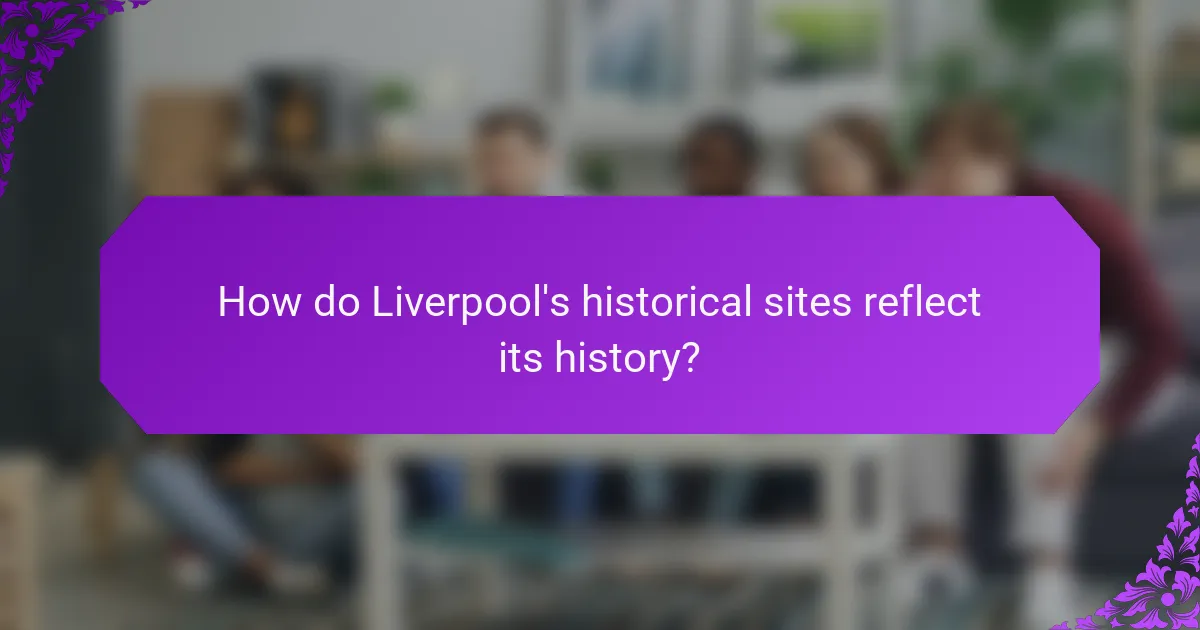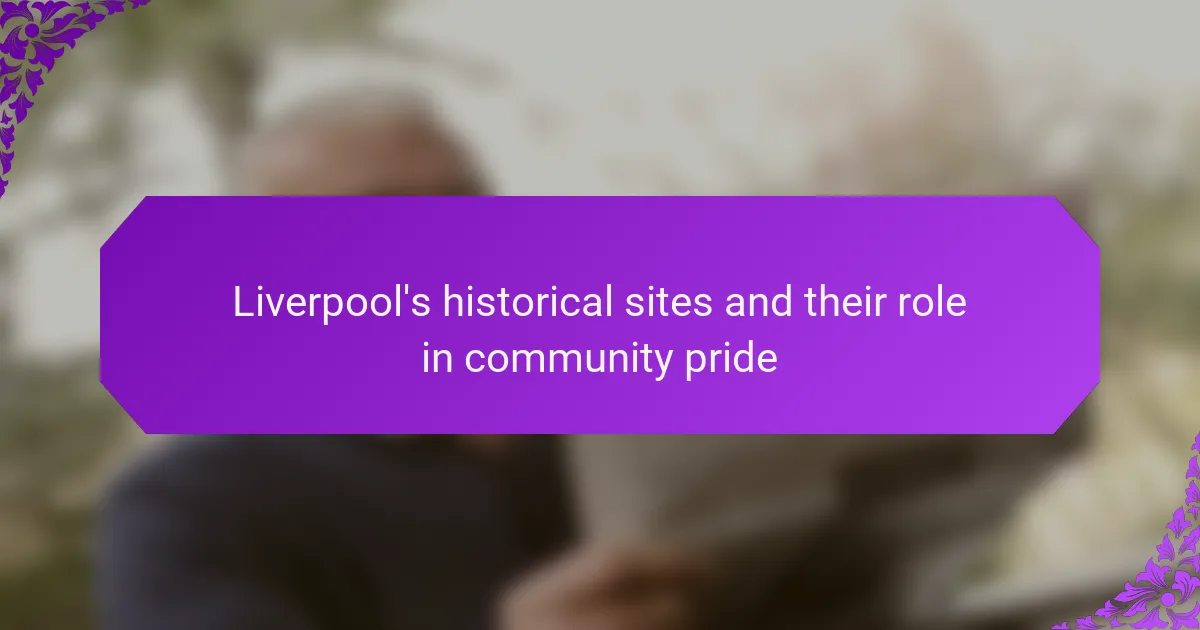Liverpool’s historical sites, including the Royal Albert Dock, St. George’s Hall, and the Liverpool Cathedral, play a vital role in shaping the city’s identity and fostering community pride. The Royal Albert Dock, recognized as a UNESCO World Heritage Site, highlights Liverpool’s maritime history, while St. George’s Hall is noted for its neoclassical architecture. The Liverpool Cathedral, one of the largest in the UK, exemplifies Gothic revival design. These sites not only attract millions of visitors annually, enhancing the local economy, but also serve as focal points for community events and historical education, reinforcing the connection between residents and their rich cultural heritage.

What are Liverpool’s historical sites?
Liverpool’s historical sites include the Royal Albert Dock, St. George’s Hall, and the Liverpool Cathedral. The Royal Albert Dock is a UNESCO World Heritage Site, known for its maritime history. St. George’s Hall is famous for its neoclassical architecture and cultural significance. The Liverpool Cathedral, one of the largest in the UK, showcases impressive Gothic revival design. Other notable sites are the Beatles Story museum and the Town Hall, reflecting the city’s rich musical and civic heritage. These sites contribute to Liverpool’s identity and community pride.
How do these sites contribute to Liverpool’s identity?
Liverpool’s historical sites contribute significantly to the city’s identity. They embody the rich maritime heritage and cultural legacy of Liverpool. Notable sites, such as the Royal Albert Dock, showcase the city’s role in global trade. The waterfront area, a UNESCO World Heritage Site, highlights Liverpool’s historical significance. Museums like the Merseyside Maritime Museum preserve local history and stories. These sites attract millions of visitors annually, enhancing community pride. They serve as venues for cultural events, fostering local engagement. The preservation of these sites reinforces a sense of belonging among residents.
What are the most significant historical sites in Liverpool?
The most significant historical sites in Liverpool include the Royal Albert Dock, St. George’s Hall, and the Liverpool Cathedral. The Royal Albert Dock, completed in 1846, is a UNESCO World Heritage Site. It showcases the city’s maritime history and architectural heritage. St. George’s Hall, built in the 19th century, is renowned for its neoclassical design and serves as a concert hall and law court. The Liverpool Cathedral, completed in 1978, is the largest cathedral in the UK and an iconic symbol of the city. Other notable sites include the Walker Art Gallery and the Pier Head, which features the famous Three Graces. These sites reflect Liverpool’s rich cultural and historical significance.
How have these sites evolved over time?
Liverpool’s historical sites have evolved significantly over time. Initially, many sites served practical purposes, such as trade and transportation. The city’s docks were vital for maritime commerce in the 18th and 19th centuries. As industries changed, some sites were repurposed for cultural and recreational use. The Albert Dock, for example, transformed from a commercial hub into a tourist destination. Restoration efforts have also played a crucial role in preserving architectural heritage. The city’s investment in heritage conservation reflects a growing appreciation for its historical identity. This evolution has fostered community pride and engagement with local history. Today, these sites are celebrated as symbols of Liverpool’s rich cultural narrative.
Why are historical sites important to the community?
Historical sites are important to the community because they preserve cultural heritage. They serve as tangible reminders of a community’s history and identity. These sites facilitate education about local traditions and events. They promote tourism, which can boost the local economy. For instance, Liverpool’s historical sites attract visitors, generating revenue for local businesses. Additionally, they foster community pride and cohesion. Engaging with these sites encourages residents to connect with their heritage. This connection can lead to increased civic engagement and community activism.
What role do they play in local culture?
Liverpool’s historical sites play a crucial role in local culture. They serve as symbols of the city’s rich heritage and identity. These sites foster community pride and connection among residents. Landmarks like the Royal Albert Dock and St. George’s Hall attract both locals and tourists. They host events that celebrate Liverpool’s history and traditions. Historical sites also contribute to the local economy through tourism. Their preservation reflects the community’s commitment to cultural heritage. Overall, these sites are vital for maintaining Liverpool’s unique cultural landscape.
How do historical sites influence community pride?
Historical sites enhance community pride by serving as symbols of local heritage and identity. They provide a tangible connection to the past, fostering a sense of belonging among residents. For example, Liverpool’s waterfront and its maritime history are celebrated as UNESCO World Heritage Sites. This recognition boosts local pride and attracts tourism, which benefits the economy. Additionally, historical sites often host community events and educational programs. These activities encourage local engagement and strengthen community ties. The preservation of historical sites reflects a community’s commitment to its culture and history. This dedication further cultivates pride among residents.

How do Liverpool’s historical sites reflect its history?
Liverpool’s historical sites reflect its history through their architectural styles and cultural significance. The city showcases a blend of Gothic, Victorian, and modern designs. Notable structures include the Royal Albert Dock, which highlights Liverpool’s maritime trade legacy. The Liverpool Cathedral represents the city’s religious heritage and is one of the largest cathedrals in the UK. The Pier Head, featuring the iconic Three Graces, symbolizes Liverpool’s status as a major port city. These sites are not only tourist attractions but also serve as reminders of the city’s industrial past and cultural evolution. They contribute to community pride by celebrating Liverpool’s unique identity and historical achievements.
What key events are associated with these sites?
Key events associated with Liverpool’s historical sites include the establishment of the Liverpool Maritime Mercantile City as a UNESCO World Heritage Site in 2004. This designation recognized the city’s significance in global trade during the 18th and 19th centuries. The Liverpool International Music Festival, held annually, celebrates the city’s musical heritage linked to its iconic venues. The opening of the Royal Albert Dock in 1988 revitalized the waterfront and enhanced community engagement. Additionally, the Hillsborough Memorial, located at Anfield, commemorates the 1989 tragedy, fostering community solidarity. These events highlight the city’s rich history and its residents’ pride in their cultural heritage.
How do these events shape the narrative of Liverpool?
Events shape the narrative of Liverpool by highlighting its rich history and cultural significance. Key events, such as the establishment of the Port of Liverpool in the 18th century, underscore its role as a major trade hub. The city’s participation in the Industrial Revolution further emphasizes its economic impact and innovation. Additionally, cultural milestones, like the Beatles’ rise to fame in the 1960s, have cemented Liverpool’s identity in popular culture. These events foster a sense of pride among residents and contribute to community cohesion. Historical sites, such as the Royal Albert Dock and St. George’s Hall, serve as reminders of these pivotal moments. They attract tourism, which strengthens the local economy and reinforces community identity. Collectively, these elements create a narrative that celebrates Liverpool’s resilience and creativity.
What stories do the sites tell about the city’s past?
Liverpool’s historical sites tell stories of maritime trade, cultural exchange, and industrial growth. The Albert Dock represents the city’s significance as a major port in the 19th century. The stories of the dock highlight the role of Liverpool in the transatlantic trade. The city’s architecture reflects its wealth from shipping and commerce. St. George’s Hall illustrates civic pride and the importance of public spaces. The Beatles Story Museum narrates the cultural impact of the Beatles on global music. These sites collectively showcase Liverpool’s evolution and resilience throughout history. Each location serves as a testament to the city’s rich heritage and community identity.
In what ways do these sites promote community engagement?
Liverpool’s historical sites promote community engagement through educational programs, public events, and volunteer opportunities. These sites often host workshops that teach local history and heritage. They also organize festivals that celebrate cultural traditions, drawing community members together. Additionally, many historical sites encourage volunteerism, allowing residents to contribute to preservation efforts. This involvement fosters a sense of ownership and pride among locals. Research shows that such engagement strengthens community bonds and enhances social cohesion. By actively participating, residents form connections with their heritage and each other.
How do local organizations utilize historical sites for events?
Local organizations utilize historical sites for events by hosting community gatherings, educational programs, and cultural celebrations. These events leverage the unique ambiance and significance of the sites. For example, organizations may conduct historical tours or reenactments that educate attendees about Liverpool’s heritage. They often collaborate with local historians to enhance the educational value of these events. Furthermore, events held at historical sites can attract tourism, boosting local economies. According to a report by the Heritage Lottery Fund, heritage sites can increase community engagement and pride. This engagement fosters a sense of belonging among residents.
What initiatives exist to preserve these sites?
Various initiatives exist to preserve Liverpool’s historical sites. The Liverpool City Council implements conservation strategies for heritage buildings. The National Lottery Heritage Fund supports restoration projects financially. Local community groups engage in advocacy and awareness campaigns. Historic England provides guidelines and resources for preservation efforts. The Liverpool Echo’s “Save Our Heritage” campaign raises public awareness. Partnerships with universities promote research on historical significance. These initiatives collectively aim to maintain Liverpool’s rich cultural heritage for future generations.

What is the impact of Liverpool’s historical sites on community pride?
Liverpool’s historical sites significantly enhance community pride. These sites, such as the Royal Albert Dock and St. George’s Hall, serve as symbols of the city’s rich maritime and cultural heritage. They attract millions of visitors each year, boosting local economy and fostering a sense of identity among residents. Community events often take place at these locations, strengthening social bonds. Historical education initiatives related to these sites help instill pride in local history. Furthermore, preservation efforts demonstrate a commitment to cultural heritage, reinforcing community values. Overall, Liverpool’s historical sites play a crucial role in uniting residents and promoting pride in their city.
How do residents perceive their historical sites?
Residents perceive their historical sites as vital symbols of their identity and culture. Many view these sites as sources of pride and connection to their heritage. Historical sites in Liverpool, such as the Albert Dock and the Royal Liver Building, are often celebrated for their architectural significance. Local surveys indicate that a majority of residents feel a strong emotional attachment to these landmarks. This connection fosters a sense of community and belonging among the inhabitants. Additionally, residents often participate in events and activities centered around these historical sites. Such engagement reinforces their importance in everyday life. Overall, the perception of historical sites contributes positively to community pride in Liverpool.
What feelings do these sites evoke among locals?
Liverpool’s historical sites evoke feelings of pride and nostalgia among locals. These sites represent the city’s rich maritime heritage and cultural history. Many residents feel a strong connection to their ancestry through these landmarks. The Albert Dock, for example, is a symbol of Liverpool’s past as a major port. Locals often express admiration for the architectural beauty of these sites. They also serve as gathering places for community events, fostering a sense of belonging. Historical sites often inspire local initiatives aimed at preservation and education. Overall, these feelings contribute to a shared identity among the people of Liverpool.
How do historical sites foster a sense of belonging?
Historical sites foster a sense of belonging by connecting individuals to their cultural heritage. These sites serve as tangible reminders of shared history and collective identity. For example, Liverpool’s maritime history is embodied in its historic docks. Such locations evoke memories and stories that resonate with local communities. Research shows that engagement with historical sites can enhance community pride. A study by the University of Liverpool found that local residents feel more connected to their community when they participate in heritage activities. Historical sites also provide spaces for social interaction, allowing people to gather and share experiences. This communal engagement strengthens bonds among residents, reinforcing their sense of belonging.
What are some examples of community events centered around historical sites?
Community events centered around historical sites include guided walking tours, reenactments, and heritage festivals. Guided walking tours often highlight significant landmarks in Liverpool, such as the Albert Dock and St. George’s Hall. Reenactments can bring historical events to life, engaging local residents and visitors alike. Heritage festivals celebrate local culture and history, featuring music, food, and crafts. These events foster community pride by connecting residents to their city’s rich past. For example, the Liverpool Heritage Festival showcases the city’s history through various activities and exhibitions. Such events not only educate attendees but also strengthen community bonds.
How do these events strengthen community bonds?
Events centered around Liverpool’s historical sites strengthen community bonds by fostering shared experiences and collective identity. These gatherings allow residents to engage with their local heritage. Participation in events encourages interaction among community members. This interaction builds trust and understanding. Historical sites serve as focal points for community pride. They remind residents of their shared history and culture. Studies show that community events enhance social cohesion. For example, a 2018 report by the Local Trust found that local events increased community engagement by 30%.
What role do schools and education play in connecting youth with historical sites?
Schools and education play a crucial role in connecting youth with historical sites. They provide structured learning experiences that foster an appreciation for local history. Educational programs often include field trips to historical sites, allowing students to engage with their heritage firsthand. These experiences enhance students’ understanding of historical events and figures relevant to their community. In Liverpool, for example, schools may organize visits to sites like the Albert Dock or the International Slavery Museum. Such initiatives help instill a sense of pride in local history among youth. Additionally, curriculum integration of local history encourages students to explore and value their cultural identity. This connection between education and historical sites supports community engagement and promotes lifelong learning.
What can residents do to support Liverpool’s historical sites?
Residents can support Liverpool’s historical sites by volunteering for preservation efforts. They can participate in local clean-up days organized by heritage groups. Residents can also attend events at these sites to boost visitor numbers. Supporting local businesses near historical sites helps maintain the area’s economic viability. Joining local history societies fosters community engagement with heritage. Advocating for funding and protection of these sites raises awareness of their importance. Lastly, residents can educate others about Liverpool’s history to promote appreciation. These actions contribute to preserving the cultural legacy of the city.
Liverpool’s historical sites, including the Royal Albert Dock, St. George’s Hall, and the Liverpool Cathedral, play a crucial role in shaping the city’s identity and fostering community pride. These sites reflect Liverpool’s rich maritime and cultural heritage, attracting millions of visitors annually and serving as venues for local events. The article explores the significance of these historical landmarks, their evolution over time, and their impact on community engagement and cohesion. Additionally, it highlights initiatives for preservation and the vital role of education in connecting youth with their local heritage.
